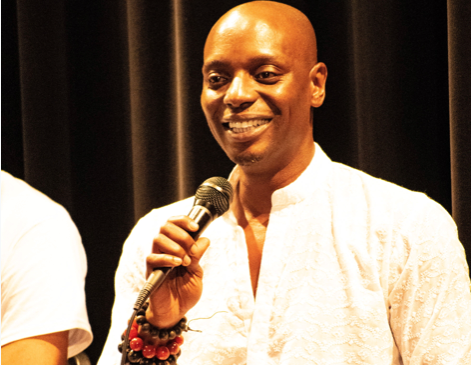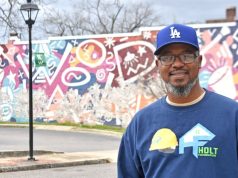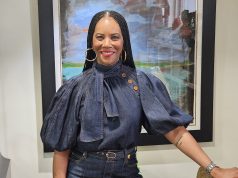By Ameera Steward
The Birmingham Times
Internationally recognized dancer and choreographer Germaul Barnes could have chosen anywhere in the world to teach, but he will be at the Alabama School of Fine Arts (ASFA) this fall, serving as a dance instructor for the 2019 school year.
“I don’t think I chose Birmingham. Birmingham chose me,” said Barnes. “I have been coming here, seeing the uniqueness, seeing the vibrancy in Birmingham, … in some way, feeling a little part of that vibration for me being here. … There comes a time when, as an artist … I am interested in being in an environment that is healthy, encouraging about not only my own artistry but the next generation.”
ASFA is a unique place for talent, he said: “ASFA has a long history of developing some amazing artists. Over my travels, I’ve run across quite a few alumni from here, so I feel this is a place that allows young people to really, genuinely find their voice, really find their perspective and develop … to go into their professional realm or continue education in whatever field they are in.”
Barnes pointed to two recent ASFA graduates, Rachel Lockhart and Haley Winegarden, who will be attending The Julliard School, a highly selective, world-renowned performing arts institution in New York City that accepts only a small number of students.
“That tells you about the wealth of information these kids are getting,” Barnes said. “For me to be part of that is exciting. I can actually share all these things that people have generously given to me. … The universe has put me into this spot, so I can share that and … actually see growth, actually see development of a young person. Birmingham is the place that’s doing it. ASFA is the place that’s doing it.”
Award Winner
Barnes, 47, has received nearly every major accolade in the dance community, including a New York Dance and Performance Award, also known as the Bessie Award—“which is like the Oscars of the dance world,” he said.
“The Bessies have saluted outstanding and groundbreaking creative work by independent dance artists in [New York City] for 35 years.
The awards, known as ‘The Bessie’ in honor of revered dance teacher Bessie Schönberg, were established in 1984 and recognize exceptional work in choreography, performance, music composition, and visual design,” according to bessies.org.
Also, in 2018 Barnes received a proclamation from the borough of Brooklyn, N.Y., for service and a citation from New York City Mayor Bill de Blasio.
In his role as dance instructor, Barnes aims to bring a sense of collaboration not only to ASFA but also to the city of Birmingham.
“If we can cross disciplines, cross ethnicities, cross economic divides … how mighty this world would be, how mighty a community would be? We would have a sense of understanding of each other,” he said.
Honoring His Lineage
The respected choreographer, who was born and raised in Phoenix, Ariz., said he came out of the womb dancing.
“My mom says I started dancing as a fetus. I came out kicking and turning,” Barnes said. “I’ve always danced. I did local talent shows. … I started … in parks-and-recreation programs. Any free program that was offered, I was there.”
For Barnes, dancing was natural.
“I was always moving, always had a lot of energy, … [always] running around,” he said. “Dance was the only place where I could really feel myself, … [use] all that energy … and just be creative.”
He’s always had support from his family, too: his mom, dad, and three sisters.
“Still, today, [the dance studio] … is my home; this is my church.”
At age 7, he enrolled in ballet, modern jazz, and tap dance classes. At 10, he moved on to the Phoenix School of Ballet. He continued on that track all the way through high school. When he graduated from South Mountain High School in Phoenix, he knew it was time to leave his hometown.
“My mom always told [my sisters and me] to get out of Arizona,” said Barnes. “[She said], ‘Go get your education somewhere else. If you decide to come back, then come back.’”
Barnes said his mother, who passed away earlier this year, has always been his biggest inspiration.
“She showed a strength, a resilience that is unmatchable,” he said. “She gave me a sense of self, allowed me to be [myself]. [She encouraged] my sisters and me … to be whatever we chose to [be], however we chose to develop.
“By my mom passing at the beginning of this year, I really felt like I can really step into the idea of what it means to be an adult [because] I think I am much more aware of my creativity. I also have a responsibility to honor my ancestors and honor my lineage, and … pass down that same respect and awareness to the next generation.”
Studying the Craft
Barnes embarked on his travels with the Pacific Conservatory Theater in Santa Maria, Calif., which created different works and went on tour to perform them in different cities across the state. “A Chorus Line,” for instance, was a musical about performers auditioning for a job.
“There’s the one black character named Richie Walters. I was that person right out of high school,” said Barnes, who also performed in “Guys and Dolls” during his time in California.
Still, he realized that he needed more instruction.
“I thought I wanted to do musical theater [and] was going to Broadway, [but I] realized I couldn’t sing. Then I decided to study dance, so I went to college,” said Barnes, who went on to attend the University of the Arts (UArts) in Philadelphia, Pa., which was the only school that offered a major in jazz and education at the time.
“I was going to major in musical theater jazz with a minor in education,” he said.
When Barnes got to the school, he was sent to the modern dance department, which he gravitated toward. Though he had done modern dance before, he said, “as a young person, what you see and what you desire are not necessarily what your path will lead you to.”
“Once I got to college, I was like, ‘OK, modern dance is what I’m more passionate about.’”
In Philadelphia, Barnes was exposed “to a variety of dances, a variety of ideas and expressions that I did not see,” he said.
“The representation of who I am as a black man, it was the introduction to that. [I saw that] this could be a career for a black person. … [When I looked at] what was on television … [and in] the dance programs, [I] rarely saw a representation of people of color.”
Also, Barnes pointed out that UArts had a diverse staff: “It’s in Philadelphia, the city of brotherly love, and it was a place where I could feel comfortable being in the city, close to New York but not in New York.”
Releasing Insecurities
While at UArts, Barnes danced with the local Group Motions Dance Company, where he began his world travels, including a trip to Berlin, Germany: “I just fell in love with the city,” Barnes recalled.
He attended a show there and was so stunned by what he saw that he went to the director and said, “I’m going to work with you.”
Barnes told the director he loved the innovation and the physicality of the performance, and the director invited Barnes to visit his studio the next day. Barnes, who didn’t speak German, found his way to the studio after meeting a woman on a bus who led him to the studio.
“My audition to get into the company was to explain how I got there,” said Barnes. “So, I told the story, and [the director asked], ‘Would you like to join my company?’”
Barnes spent three years in Berlin with the Toláda Dance Company but still felt, “I needed to learn … not only about dance but also about myself,” he said.
“Berlin was that place where I could be not just another black man but first an American. … Berlin was that place where my insecurity about my features—my big lips, my big ass—was an asset. So, I worked through those personal things, but I still felt like I needed to learn more about and contribute to my culture.”
“Forming His Own Company”
Barnes reached out to several black companies in the United States, including the Cleo Parker Robinson Dance Ensemble in Denver, Colo., which has worked with some of the best in dance: Eleo Pomare, Katherine Dunham, Donald McKayle, and Dianne McIntyre.
“I called [Robinson] and said, ‘Hey, I’m going to dance with you.’ She said, ‘Come on, baby.’ … [Robinson] was working with all the living legends at the time and or doing their work. … I chose to go to the Cleo Parker Robinson Dance Ensemble because [it gave me the opportunity to] dance, have a job, and learn about the African Diasporic work,” said Barnes, who added that he’d had a relationship with the renowned company and instructor in high school, “but [Robinson] hadn’t seen me dance in years.”
Barnes said he has learned to incorporate black influence into his work because “I can’t avoid it, it’s me.”
“Even if I’m doing something off of Beethoven or Bach, I’m a black man in a black body that’s lived a black experience that is about the world; that is represented of the world,” he said. “It’s not anything I necessarily have to seek out or feel that it’s more important. It’s just who I am. … Being an African American male in America, just saying you are an artist, saying you are happy with self … is already radical … I don’t have to work at that.”
Barnes said his artistry offers people “humanity through a global perspective.”
In 1996, he moved to New York City and felt he was home when he joined the Harlem-based Bill T. Jones/Arnie Zane Dance Company, where he stayed for nearly a decade. In 2005, Barnes founded his own company, Viewsic Dance, a project-based dance company.
“I always wanted to choreograph. I always wanted to do my own,” Barnes said. “In between and even during working with other companies, I’d always done my own work, so it was natural for me to then branch out on my own and really try my feet at having my voice be heard, along with … collaborating.”
“Not Like Everybody Else”
Barnes also has commissioned work from other choreographers, including a project called “Black Bones,” through which he showed a lineage of black male choreographers with social and political ideas. “What they called the radicals,” said Barnes.
Viewsic helped Barnes develop another skill, as well: costume design.
“It came out of necessity because if you couldn’t afford [costumes and a costume designer], … you go to American Apparel, Gap, and you start looking like everybody else,” he said. “One thing you’ll know about me is that I’m not like everybody else.”
Barnes said his costumes are specific for what he’s creating at the time, and he also is conscious of who he is dressing.
“What is the message I want to say in the work? … How are the bodies going to feel in the fabric? How is that going to translate to the ultimate vision of what I’m trying to say or what someone else is trying to say? I’ve costumed other people’s work, too,” he said, adding that he recently did a work for the Alabama Ballet that premiered in April for which he designed the costumes and the set and choreographed the work.
“As a dancer, as an artist, … if you love the feel of it, typically you love all the aspects … that go into it,” Barnes said. “From lighting to makeup design to costumes to flooring, there are so many elements that go into creating a production. I love it all.”
Inspirational Work
Barnes, who loves sewing, designing, and consulting other artists, said his spiritual practice Buddhism is the way he spends his time away from dance. He also gets inspiration from theatrical productions and visual art, as well as music concerts. All forms of music motivate Barnes.
“I use everything: … blues, bluegrass, bebop, rap, classical music. … Sound really motivates a lot of what my design work is.”
Social Responsibility
Teaching is natural for Barnes, who has taught at Yale University and the University of Michigan, as well as ASFA, where he has been a resident guest artist for seven years. What he loves about ASFA is that students are so open to learning.
“They are amazing dancers who can go anywhere,” Barnes said. “What I bring is how to take that technical experience and then put it into real life; how to actually use it not only in the physicality but how to connect it mentally and spiritually. How do you take this thing called dance and use it to develop good people in society?
“Dance has afforded me [the opportunity] to visit every continent in the world, except for Antarctica. Dance has afforded me [the opportunity] to sit at tables most people were not invited to. Dance has afforded me [the opportunity] to be here in Alabama, to be a new instructor at ASFA, to be able to affect the young and share what I have experienced with these young minds.”
Barnes wants students “to find joy in everything they do, not only in the studio but also in life.”
“Even as a dancer, you have a social responsibility to your community and to your lineage. … I try to teach that … whatever you do, you are a representative of someone greater than you.”
In 2002, Barnes created a dance technique and methodology called JOY because, as a teacher, he found kids that are technically proficient, “but I didn’t see the joy.”
“I didn’t see the people. I didn’t see the life. I didn’t see why we do what we do,” he said. “Through that and through all of my other experiences, … what I teach is joy—why we do what we do; getting to the essence of the expression of dance; how to move through space [and] transmit the person’s inner … life force out of which comes this is joy. This is why we do what we do.”
Asked who he looks up to, Barnes said, “I have looked up to everyone I have come across. Even the younger generation. … I look up to the next generation and how brilliant, how quick they are.”
Barnes said he now he looks up to himself, too: “I now have really seen that I possess something that is unique to me.”










